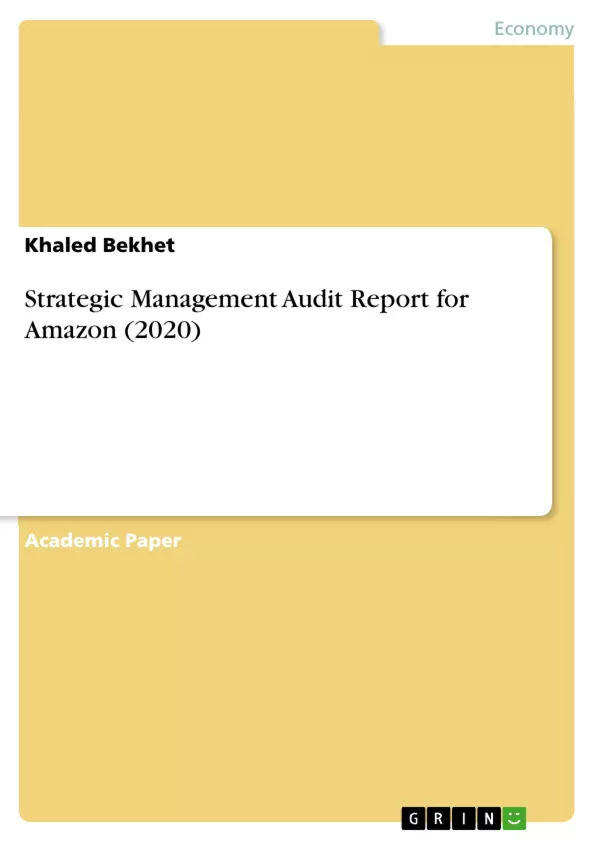A strategic audit is an in-depth review to determine whether a company is meeting its organizational objectives in the most efficient way. Additionally, it examines whether the company is utilizing its resources fully. A successful strategic audit is beneficial to any company. It assesses various aspects of a business and evaluates and determines the most appropriate direction for the company to move toward in achieving its goals.
The purpose of this research is to examine Amazon’s worldwide position, as well as how its present business plan compares to its rivals and fits within the company's global outlook. The research was done utilizing financial data and public information from the company's website to see where they shine and where they fall short. To better analyze Amazon.com and identify areas for development, graphs and comparative studies were created. The charts and tables that support the data are included in the following report. According to the findings of the data analysis, Amazon is a very successful company that continues to be a dominant competitor in the online retail market. The researcher applied the most known tools in strategic management to assess the company’s competitive strategy.
Inhaltsverzeichnis (Table of Contents)
- Executive Summary
- The Company
- Amazon's mission statement
- Amazon's corporate vision statement
- Amazon's Generic Strategy (Porter's Model)
- Products and Services
- External Environment
- PESTEL Analysis
- Political Factors
- Ecological Factors
- Social Factors
- Technological Factors
- Economic Factors
- Legal Factors
- Competitive environment
- Competitive Rivalry
- Threats of New Entrants
- Bargaining Power of Suppliers
- Bargaining Power of Buyers
- Threats of Substitutes
- IFE Analysis
- EFE Analysis
- CPM Matrix
- IE Matrix
- VRIO Framework
- Competitive Advantages, Core Competencies
- Non-core Competencies
- Value Chain Analysis
- Primary Activities
- Inbound Logistics
- Operations
- Outbound Logistics
- Marketing and Sales
- Service
- Support Activities
- Infrastructure
- Human Resource Management
- Technology Development
- Procurement
- Amazon's SWOT Matrix
- SPACE Matrix
- Strategy recommendations
- QSPM Matrix
- Strategy Recommendations
- References
Zielsetzung und Themenschwerpunkte (Objectives and Key Themes)
This report aims to analyze Amazon's global position, its current business strategy, and its competitive landscape. It uses financial data and public information from Amazon's website to evaluate the company's strengths and weaknesses. The report also applies strategic management tools to assess Amazon's competitive strategy.
- Amazon's global market position and competitive advantage
- Analysis of Amazon's business strategy using Porter's Five Forces model and other frameworks
- Identification of Amazon's core competencies and potential areas for growth
- Evaluation of Amazon's external environment, including political, economic, social, technological, environmental, and legal factors
- Development of strategic recommendations for Amazon's future growth and sustainability
Zusammenfassung der Kapitel (Chapter Summaries)
The report begins with an executive summary that provides a concise overview of Amazon's position in the online retail market. Chapter 2 delves into the history of Amazon, tracing its growth from an online bookstore to a global e-commerce giant. The chapter covers Amazon's mission statement, corporate vision, and key milestones in its development. Chapter 3 examines Amazon's products and services, highlighting the company's diverse offerings and its expansion into new markets. Chapter 4 analyzes Amazon's external environment, using PESTEL analysis to identify potential opportunities and threats. Chapter 5 evaluates Amazon's competitive landscape using Porter's Five Forces model, providing insight into the company's competitive strengths and weaknesses. Chapters 6 to 10 further analyze Amazon's strategic position using tools such as IFE, EFE, CPM, and IE matrices, as well as VRIO framework. Chapter 11 examines Amazon's value chain, analyzing its primary and support activities. Chapter 12 explores Amazon's SWOT matrix, highlighting the company's strengths, weaknesses, opportunities, and threats. Chapter 13 utilizes the SPACE matrix to assess Amazon's strategic position based on its internal and external factors. Chapter 14 provides strategic recommendations for Amazon's future growth, considering its competitive advantages, core competencies, and potential areas for development. Chapter 15 utilizes the QSPM matrix to evaluate the strategic alternatives and prioritize recommended strategies. The report concludes with a list of references used in the research.
Schlüsselwörter (Keywords)
The report focuses on Amazon's strategic management, competitive analysis, global market position, e-commerce, online retail, Porter's Five Forces, SWOT analysis, PESTEL analysis, IFE, EFE, CPM, IE, VRIO, value chain, strategic recommendations, and QSPM. These keywords represent the core concepts and themes explored in the report, providing a comprehensive understanding of Amazon's current strategic landscape.
- Quote paper
- Dr Khaled Bekhet (Author), 2020, Strategic Management Audit Report for Amazon (2020), Munich, GRIN Verlag, https://www.grin.com/document/1183677



